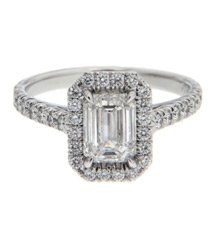Noble Metal
Overlapping with precious metals, the distinguishing feature of noble metals are their resistance to corrosion and oxidation in moist or warm air. The term was first used in Middle English between 1350 and 1400, though at the time it referred to precious metals. As well as being useful in the construction of computers and other advanced technology, they are commonly used to create jewelry and other precious objects. Noble metals include gold, silver, palladium and platinum. Of these, all but silver is soluble with the substance aqua regia, though silver can be dissolved with nitric acid. Strong resistance to corrosion makes some noble metals a stable choice for jewelry. While there are other metals which are noble, they don’t have the malleability or ductility desired in precious metal.
Malleability
Related to ductility, malleability refers to precious metals’ reactions to compression. A material with high malleability will endure without breaking. Material unable to withstand rolling, extrusion, or hammering would make a less than ideal medium for jewelry. Gold is the most malleable of metals, able to be flattened the delicate pieces known as leaf. Silver doesn’t have the same flexibility, but can also turn onto the thinnest of sheets. Platinum may not be as malleable, but has enough of the property to take on complex shapes.
Work Hardening
When metal experiences stress, its molecular structure changes. Also known as strain or cold hardening, work hardening adds strength and stiffness to a room temperature piece of metal. The more an item is subjected to strains such as pulling or hammering, the less ductile it becomes.
As a piece grows more work hardened, more effort and stronger equipment is required to shape the material. Strain can create rigid metal, which may be problematic depending on the design of jewelry. The effects of work hardening may be reversed with careful heat application. When used in conjunction with other processes like annealing and casting, work hardening helps to create beautiful and durable jewelry.
Ductility
When making jewelry from precious metal, it’s important for the metal to react favorably to manufacturing. Ductility refers to the ability to deform under tension without breaking. Materials with low ductility are likely to break when pulled, hardly stretching. While ductility has some elements in common with malleability, metal may be weak in one area but stronger in another. Of the materials with the highest ductile properties, gold is the best, followed by silver and platinum. Part of what makes precious metal desirable for jewelry is its ability to be shaped, when cold as well as heated. Whether it’s drawing wire or making an embossed design, ductility helps determine what can be done.
Hallmark
Not to be confused with a maker’s mark, a hallmark is a stamp impressed on precious metal, attesting to its purity. Hallmarks are traditionally stamped on softened metal, though in modern times, lasers may engrave the precious metal. These symbols have been used since the Byzantine Empire to indicate that the metal has been inspected and is of approved quality. Depending on the era, place and material in question, the hallmark may indicate an alloy of exact ratios, such as sterling silver’s 92.5% silver to 7.5% other metals. Hallmarks may be used to determine when and where an antique piece of jewelry originates, as well as its composition. For example, France used the profile of a horse’s head to indicate a watch or piece of jewelry was solid 18K gold between the years of 1838-1919. Though there have been efforts to make an international standard of hallmarks, standards vary by country, making agreement difficult.
Fantasy cuts
Gemstones are traditionally faceted with a series of flat angles over much of the stone. This type of cutting tries to concentrate the jewel’s color and improve its ability to take in and reflect light. Certain features such as broad bottom facets were to be avoided. In recent decades, some jewelers have taken a more novel approach, using unconventional facets to create never before seen cuts.
Popularized by Bernd Munsteiner, the fantasy cut is a free form lapidary style that encourages artists to experiment with jewels and their optical properties. Grooves, concave facets and curved planes are all used, with specialized equipment created to better make these cuts. Large stones are favored for fantasy cuts, as they allow more room for lapidaries to play around and try new looks. Some fantasy cuts are available on the market while others are eye catching enough to appear in museums, with one notable aquamarine displayed in the same room as the Hope Diamond.
Cupellation
Cupellation is a process used to separate precious metals from alloys or ore. It was also utilized to test the purity of precious metal objects, until other methods came about. Cupellation is documented as far back as the Early Bronze Age as a way for the people of Mesopotamia to extract silver from lead ore. The practice carried into later ages, including the Iron Age and Roman Empire, though it was first recorded in the 12 century Theophilus Divers Ars. It’s still used today as a refining technique.
The process gets its name from a tool called a cupel, a cylindrical vessel with a top wider than its bottom. To get the desired chemical reactions, cupels were made from ashes, preferably from animal bone and horn. Lead is another essential ingredient to the process, helping the desired reactions to occur. As metal heats in the vessel, any base materials oxidize and are absorbed into the cup, the precious metals remain at the bottom of the cupel.





